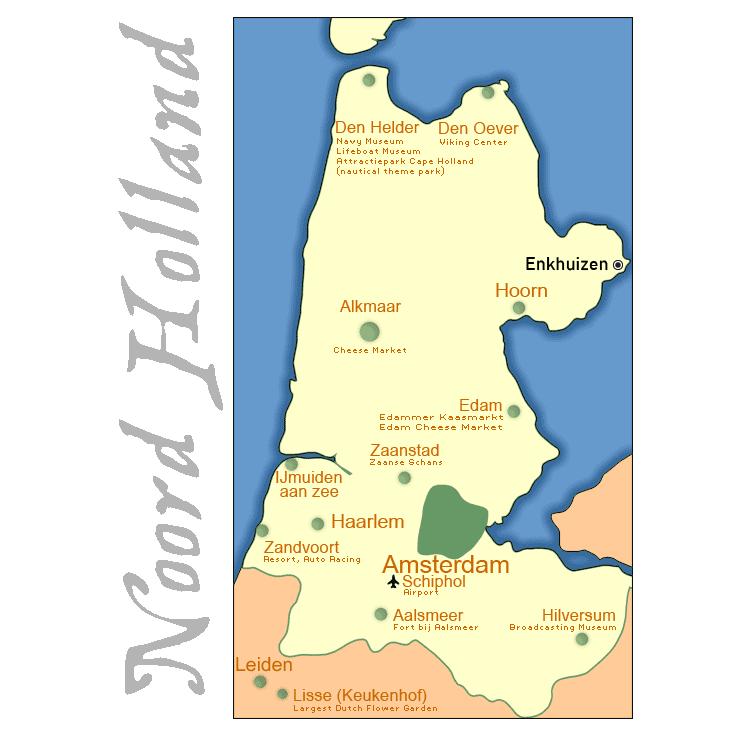The Netherlands is a relatively compact country with a lot to see in a small area. The landscape is mostly quite flat, the ideal terrain for fast trains and slow bicycles. About a quarter of the land is below sea level; rural Netherlands is a world of dikes, canals and pump stations.
Windmills dot the brooding landscape, looking to catch the wind. The tallest windmills in the world are near Rotterdam. Windmills were used to pump water, but also for grinding grain; some of that was used to produce the unique Dutch treat called jenever (Dutch gin).
But the Netherlands are much more, from the Cosmopolitan capital of Amsterdam, to the charm of Noord Holland, you'll find lots to do here.
City Map of the Netherlands Showing the Train Lines

Netherlands Provinces
The Netherlands is divided into divided into twelve provinces, many corresponding to medieval states.
Hotels and Vacation Rentals in the Netherlands
The Netherlands has a wide range of accommodations. There are usually hotels near train stations, many budget, a few seedy. You may inspect a hotel before committing to it. There are many hostels in larger cities like Amsterdam. Here is a list of the top user-rated hotels in the Netherlands.
The Netherlands countryside is largely flat and easy to walk or bike. Nature lovers might appreciate a stay in a vacation rental near the sea.
Language in the Netherlands
The language spoken in the Netherlands is Dutch (or Netherlandic). It is spoken in the Netherlands, the flanders region of Belgium, Suriname (South America) and the Netherlands Antilles. English is taught in school and is widely spoken.
If you would like to learn a few words of Dutch, there are online resources enabling you to do so. One of them is Dutch 101, which will allow you to pick up a basic reading comprehension of Dutch.
Train Transportation in the Netherlands
The Netherlands is served by an extensive rail system as you can see in the map above. There is train service from Schiphol airport to central Amsterdam and other destinations.
There are three classes of trains in Holland: the Intercity,which offers fast city-to-city connections, the Sprinter (which stops more frequently and at the smaller stations) and the high-speed trains. Most stations are centrally located. The longest train trip within the Netherlands is approximately three hours.
Travelers tell us that the wait in line to buy tickets at Amsterdam's Centraal Station can get quite long. You may want to plan your trip and buy all your train tickets at once.
Through the official Dutch Railways site you can get information or order tickets.
You can dowload a PDF brochure that explains ticketing and more: Holland by Train.
Use the box below to find flights, trains, and buses to any destination in Europe.
Climate in the Netherlands
The Netherlands enjoys a moderate climate due to its flatness and proximity to the sea. It rains frequently in the summer (10-12 days per month). For an overview of historic temperatures and rainfall throughout the year, as well as current weather information for some of the Netherlands most popular destinations see Netherlands Travel Weather.
Netherlands Food
Dinner is the main meal of the day in the Netherlands, taken around 6 or 7 o'clock in the evening. The Dutch often eat a cold lunch and a quick breakfast, but breakfast buffets in hotels can be quite filling.
NL Planet has a good page describing Dutch Food and Eating Habits
There are very good Indonesian restaurants in the Netherlands.
There are many snack bars in Holland where you can get a cheap meal. Haring (herring) are available in portable stands, in sandwiches or just by themselves. You pick up the fish and let it slide into your mouth gradually. Yum.
Service charges are included in hotel, restaurant, shopping bills and taxi fares. Tips for extra service are always appreciated but not necessary. It is customary to tip taxi drivers about 10%.
Money in the Netherlands
The currency in The Netherlands is the Euro. At the time the Euro was adopted, its value was set at 2.20371 Dutch guilders.

